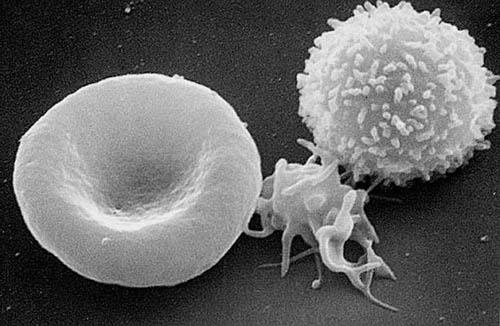USC Stem Cell researchers poke around for blood genes

From left to right, a red blood cell, a platelet and a white blood cell are shown. Credit: Public domain image courtesy of the Electron Microscopy Facility at The National Cancer Institute at Frederick
The Allayee and Adams labs performed a genetic screen of a collection of more than 100 mouse strains that are commonly used in laboratories, called the hybrid mouse diversity panel.
The researchers found that different strains have different numbers of several important sub-populations of blood stem cells, including those called “short-term HSCs,” which are responsible for the formation of red and white blood cells in adults. The activation of a gene called Hopx is associated with an increased number of short-term HSCs. The researchers further proved this finding by showing that mice lacking the Hopx gene form fewer short-term HSCs and are ineffective bone marrow donors.
“Short-term HSCs are the major stem cells in the adult bone marrow, so finding new genetic regulators of this subpopulation may have clinical benefits,” said Adams.
More broadly, the researchers have shown that the hybrid mouse diversity panel can be used to find genes that would otherwise go unnoticed.
“This powerful genetics platform has the potential to reveal the genes underlying other stem cell populations or a wide range of diseases that would be difficult to study in humans,” said Allayee.
###
The paper's lead authors are Xiaoying Zhou and Amanda L. Crow from USC, and additional contributors include: Jaana Hartiala, Tassja J. Spindler and Lora W. Barksy from USC; Anatole Ghazalpour, Brian W. Parks, Eleazar Eskin and Aldons J. Lusis from UCLA; Brian B. Bennett from the University of North Carolina, Chapel Hill; and Rajan Jain and Jonathan A. Epstein from the University of Pennsylvania.
This work was supported by the California Institute for Regenerative Medicine (grant TG2-01161), the National Institutes for Health (grants T32ES013678, K99HL102223, K99HL123021, R01ES022282, R01HL071546, P01HL30568, P01HL28481, R01ES021801, 3R01ES021801-03S1, UL1TR000130 and P3ES007048) and the Margaret E. Early Medical Research Trust.
Media Contact
All latest news from the category: Life Sciences and Chemistry
Articles and reports from the Life Sciences and chemistry area deal with applied and basic research into modern biology, chemistry and human medicine.
Valuable information can be found on a range of life sciences fields including bacteriology, biochemistry, bionics, bioinformatics, biophysics, biotechnology, genetics, geobotany, human biology, marine biology, microbiology, molecular biology, cellular biology, zoology, bioinorganic chemistry, microchemistry and environmental chemistry.
Newest articles

NASA: Mystery of life’s handedness deepens
The mystery of why life uses molecules with specific orientations has deepened with a NASA-funded discovery that RNA — a key molecule thought to have potentially held the instructions for…

What are the effects of historic lithium mining on water quality?
Study reveals low levels of common contaminants but high levels of other elements in waters associated with an abandoned lithium mine. Lithium ore and mining waste from a historic lithium…

Quantum-inspired design boosts efficiency of heat-to-electricity conversion
Rice engineers take unconventional route to improving thermophotovoltaic systems. Researchers at Rice University have found a new way to improve a key element of thermophotovoltaic (TPV) systems, which convert heat…



